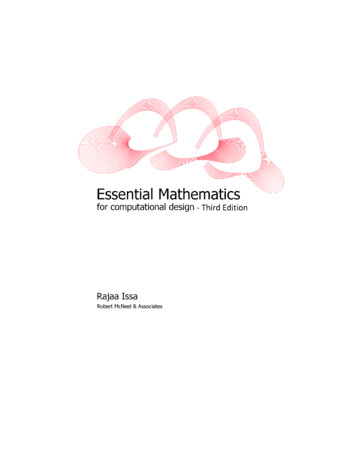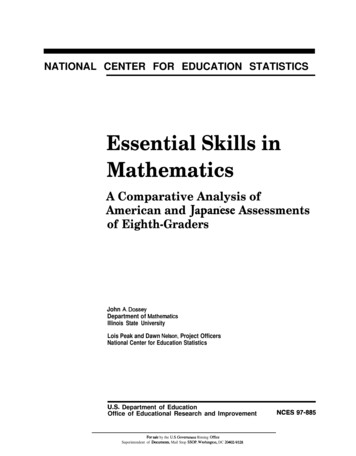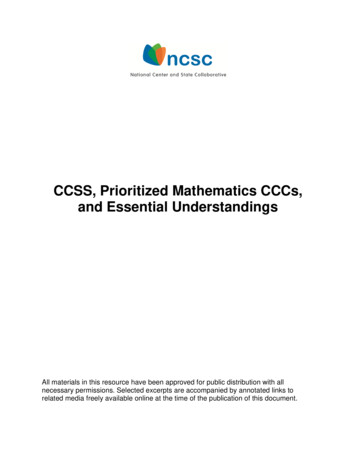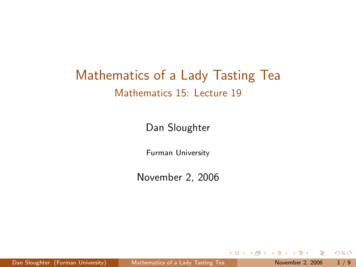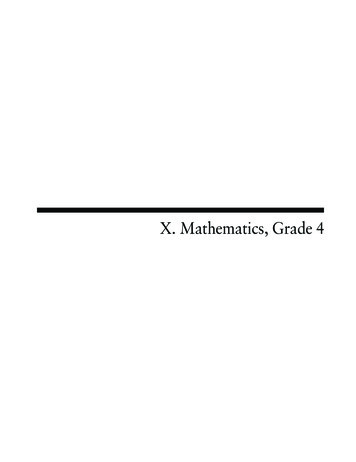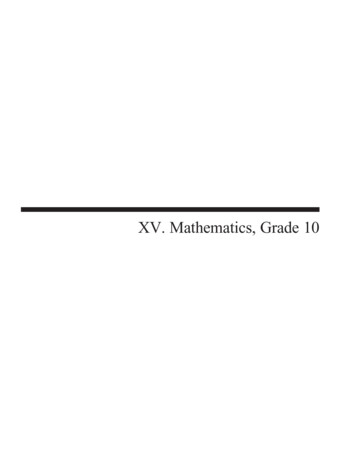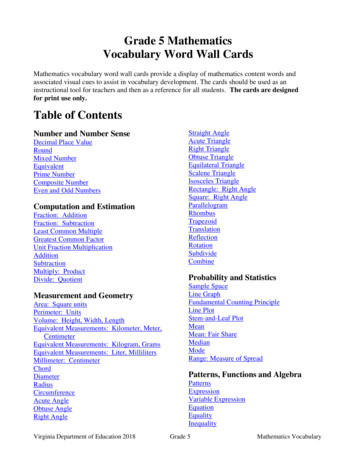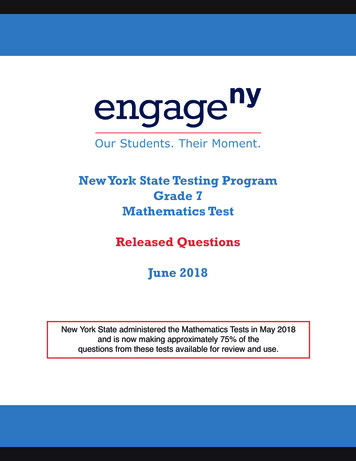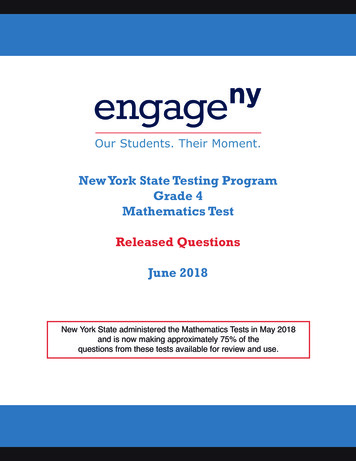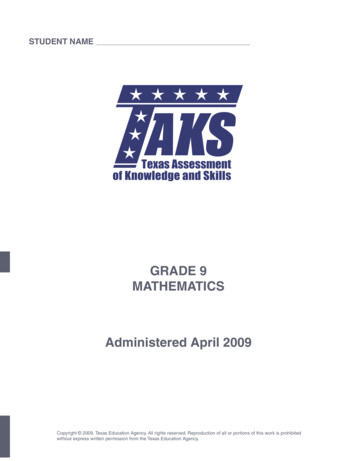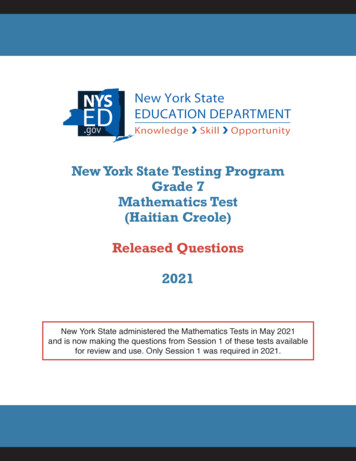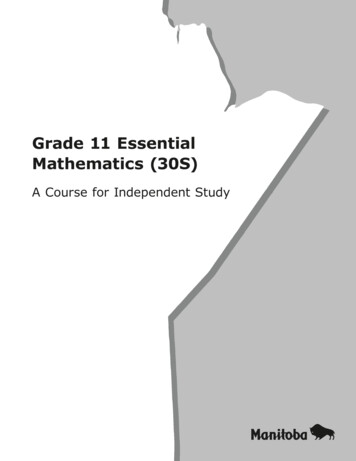
Transcription
Grade 11 EssentialMathematics (30S)A Course for Independent Study
G r a d e 11 E s s e n t i a lMathemat ics (30S)A Course for Independent Study2014M a ni t o b a E d u c a t i o n a n d A d v a n c e d L e a r nin g
Manitoba Education and Advanced Learning Cataloguing in Publication DataGrade 11 essential mathematics (30S): a course for independentstudyISBN: 978-0-7711-5836-01. Mathematics—Study and teaching (Secondary).2. Mathematics—Study and teaching (Secondary)—Manitoba.3. Mathematics—Programmed instruction.4. Distance education—Manitoba.5. Correspondence schools and courses—Manitoba.I. Manitoba. Manitoba Education and Advanced Learning.510Copyright 2014, the Government of Manitoba, represented by the Ministerof Education and Advanced Learning.Manitoba Education and Advanced LearningSchool Programs DivisionWinnipeg, Manitoba, CanadaEvery effort has been made to acknowledge original sources and to complywith copyright law. If cases are identified where this has not been done, pleasenotify Manitoba Education and Advanced Learning. Errors or omissions willbe corrected in a future edition. Sincere thanks to the authors, artists, andpublishers who allowed their original material to be used.All images found in this document are copyright protected and should notbe extracted, accessed, or reproduced for any purpose other than for theirintended educational use in this document.Any websites referenced in this document are subject to change withoutnotice.Disponible en français.Available in alternate formats upon request.
t Will You Learn in This Course?3How Is This Course Organized?3What Resources Will You Need for This Course?5Who Can Help You with This Course?6How Will You Know How Well You Are Learning?7How Much Time WIll You Need to Complete This Course?11When and How Will You Submit Completed Assignments?12What Are the Guide Graphics For?151Module 1: Interest and CreditModule 1 Introduction3Module 1 Cover Assignment: Loyalty Programs5Lesson 1: Simple Interest13Lesson 2: Compound Interest27Lesson 3: Credit Options45Lesson 4: Personal Loans57Lesson 5: Sales Promotions67Lesson 6: Credit Cards83Lesson 7: Strategies for Credit Use95Module 1 Summary103Module 1 Learning Activity Answer KeysContentsiii
Module 2: 3-D Geometry1Module 2 Introduction3Module 2 Cover Assignment: Geometric Patterns7Lesson 1: Surface Area11Lesson 2: Applications of Surface Area47Lesson 3: Units of Volume67Lesson 4: Volumes of Various Objects79Lesson 5: Applications of Surface Area95Lesson 6: Applications of Volume and Capacity111Module 2 Summary123Module 2 Learning Activity Answer KeysModule 3: StatisticsModule 3 Introduction3Module 3 Cover Assignment: Statistics in Your Life7Lesson 1: Circle Graphs11Lesson 2: Bar Graphs29Lesson 3: Histograms45Lesson 4: Line Graphs63Lesson 5: Interpreting Graphs89Module 3 SummaryModule 3 Learning Activity Answer Keysiv1Grade 10 Essential Mathematics103
Module 4: Managing Money1Module 4 Introduction3Module 4 Cover Assignment: How Time Affects the Value of Money7Lesson 1: Building a Budget11Lesson 2: Modifying Budgets39Lesson 3: Bank Accounts65Lesson 4: Cheques and Deposit Slips75Lesson 5: Cheque Registers83Module 4 Summary107Module 4 Learning Activity Answer KeysModule 5: Relations and Patterns1Module 5 Introduction3Module 5 Cover Assignment: Applying Patterns5Lesson 1: Scatterplots9Lesson 2: Patterns in Data23Lesson 3: Equations of Linear Relations37Lesson 4: Introduction to Slope61Lesson 5: Slopes of Objects79Lesson 6: Rates of Change93Lesson 7: Scale109Module 5 Summary121Module 5 Learning Activity Answer Keys1Module 6: TrigonometryModule 6 Introduction3Module 6 Cover Assignment: Math Operations5Lesson 1: Review of Right-Angled Triangles9Lesson 2: Applying Trigonometry19Module 6 Summary33Module 6 Learning Activity Answer KeysContentsv
Module 7: Design Modelling1Module 7 Introduction3Module 7 Cover Assignment: Four-Colour Problem5Lesson 1: Isometric Dot Paper13Lesson 2: Three 2-D Views of 3-D Objects33Lesson 3: One-Point Perspective Drawings65Lesson 4: Exploded Views and Component Parts75Lesson 7 Summary103Lesson 7 Learning Activity Answer KeysAppendicesvi1Appendix A: Unit Conversions3Appendix B: Glossary5Grade 10 Essential Mathematics
AcknowledgementsManitoba Education and Advanced Learning gratefully acknowledges the contributions ofthe following individuals in the development of Grade 11 Essential Mathematics (30S): A Coursefor Independent Study.WriterReviewerManitoba Education andAdvanced LearningSchool Programs DivisionStaffAmanda KonradWinnipegIrv PetersIndependent ConsultantWinklerCarole BilykProject LeaderDevelopment UnitInstruction, Curriculum and Assessment BranchLouise BoissonneaultCoordinatorDocument Production Services UnitEducational Resources BranchIan DonnellyConsultant(since February 2012)Development UnitInstruction, Curriculum and Assessment BranchLynn HarrisonDesktop PublisherDocument Production Services UnitEducational Resources BranchMyrna KlassenConsultantDistance Learning UnitInstruction, Curriculum and Assessment BranchMegan HudsonInstructional DesignAssistantDevelopment UnitInstruction, Curriculum and Assessment BranchAmanda KonradInstructional DesignAssistantDevelopment UnitInstruction, Curriculum and Assessment BranchGilles LandryProject ManagerDevelopment UnitInstruction, Curriculum and Assessment BranchPhilippe LeclercqConseiller pédagogiqueConseiller pédagogique—Mathématiques 9 à 12Division du Bureau de l’éducation française DivisionSusan LeeCoordinatorDistance Learning UnitInstruction, Curriculum and Assessment BranchGrant MoorePublications EditorDocument Production Services UnitEducational Resources BranchJohn MurrayConsultant(until August 2011)Development UnitInstruction, Curriculum and Assessment BranchAcknowledgementsvii
G r a d e 11 E s s e n t i a lMathemat ics (30S)Introduction
IntroductiontothecourseOverviewWelcome to Grade 11 Essential Mathematics!This course is a continuation of the concepts you have been studying inprevious years, as well as an introduction to new topics. You will put to usemany of the skills that you have already learned to solve problems and dobasic arithmetic operations. This course helps you develop the skills, ideas,and confidence that you will need to continue studying math in the future.As a student enrolled in a distance learning course, you have taken on a dualrole—that of a student and a teacher. As a student, you are responsible formastering the lessons and completing the learning activities and assignments.As a teacher, you are responsible to check your work carefully, noting areas inwhich you need to improve and motivating yourself to succeed.What Will You Learn in This Course?In this course, Grade 11 Essential Mathematics, you build on the knowledgeand skills you gained while studying Grade 10 Essential Mathematics.In general, the Essential Mathematics curriculum emphasizes consumerapplications, problem solving, decision making, and spatial sense. Thespecific topics studied in Grade 11 are listed below. After completingthis course, you will be well-prepared to complete Grade 12 EssentialMathematics.How Is This Course Organized?The Grade 11 Essential Mathematics course consists of the following sevenmodules:QQModule 1: Interest and CreditQQModule 2: 3-D GeometryQQModule 3: StatisticsQQModule 4: Managing MoneyQQModule 5: Relations and PatternsQQModule 6: TrigonometryQQModule 7: Design ModellingIntroduction3
Each module in this course consists of several lessons, which contain thefollowing components:Examples:QQQQQQQQQQQQLesson Focus: The Lesson Focus at the beginning of each lesson identifiesone or more specific learning outcomes (SLOs) that are addressed inthe lesson. The SLOs identify the knowledge and skills you should haveachieved by the end of the lesson.Introduction: Each lesson begins with an explanation of what you will belearning in that lesson.Lesson: The main body of the lesson is made up of the content that you needto learn. It contains text, explanations, images, diagrams, and completedexamples.Learning Activities: Many (most) lessons include one or more learningactivities that will help you learn about the lesson topics and prepare youfor the assignments, the midterm examination, and the final examination.Once you complete a learning activity, check your responses against thoseprovided in the Learning Activity Answer Key found at the end of eachapplicable module. You will not submit the completed learning activities toyour tutor/marker.Assignments: Assignments are found at the end of each lesson that hasan assignment. You will mail or electronically submit all your completedassignments to your tutor/marker for assessment at the end of each module.In total, all assignments are worth 75% of your final course mark.Summary: Each lesson ends with a brief review of what you just learned.This course also includes the following appendices:QQQQ4Appendix A: Unit Conversions: At the end of the course, you will find anappendix that contains Conversion Formula Tables. These unit conversionsare for reference use only and are not required for the exam.Appendix B: Glossary: The glossary at the end of the course providesdefinitions for an alphabetical list of the terms identified throughout thecourse. You can use the glossary to review terms used in the course.Grade 11 Essential Mathematic s
What Resources Will You Need for This Course?You do not need a textbook for this course. All the content is provided directlywithin the course. You will, however, need access to a variety of resources.The required and optional resources for this course are identified below.Required ResourcesFor this course, you will need access to the following resources. If you do nothave access to one or more of these resources, contact your tutor/marker.QQQQQQA calculator: Use a graphing or scientific calculator as you work throughthis course. You will also need the calculator for the examination(s).A metric and imperial ruler: Use the rulers as you work through thiscourse. You will also need both rulers for the examination(s).A geometry set: Use a geometry set including a set of compasses, aprotractor, and a set square for this course. You will also need the geometryset for the examination.Electronic ResourcesFor this course, you will need the following electronic resource. If you do nothave access to the Internet, or if you need a copy of the resource, contact theIndependent Study Option (ISO) office at 1-800-465-9915.QQModule 7 contains a number of diagrams that represent 2-D views of3-D objects. Module 7: Design Modelling is available in the StudentDownloads section of the distance learning website at www.edu.gov.mb.ca/k12/dl/downloads/index.html .Optional ResourcesIt would be helpful if you had access to the following resources:QQQQPhotocopier/scanner: With access to a photocopier/scanner, you could makea copy of your assignments before submitting them so that if your tutor/marker wants to discuss an assignment with you over the phone, each ofyou will have a copy. It would also allow you to continue studying or tocomplete further lessons while your original work is with the tutor/marker.Photocopying or scanning your assignments will also ensure that you keepa copy in case the originals are lost.A computer with spreadsheet software: Access to spreadsheet software(e.g., Microsoft Excel) would help you to present and analyze datagraphically.Introduction5
QQA computer with Internet access: Some lessons suggest website links assources of information or for supplementary reference and reading. If youdo not have Internet access, you will still be able to complete the course.Who Can Help You with This Course?Taking an independent study course is different from taking a course in aclassroom. Instead of relying on the teacher to tell you to complete a learningactivity or an assignment, you must tell yourself to be responsible for yourlearning and for meeting deadlines. There are, however, two people who canhelp you be successful in this course: your tutor/marker and your learningpartner.Your Tutor/MarkerTutor/markers are experienced educators who tutor ISO students andmark assignments and examinations. When you are having difficulty withsomething in this course, contact your tutor/marker, who is there to help you.Your tutor/marker’s name and contact information were sent to you with thiscourse. You can also obtain this information in the Who Is My Tutor/Marker?section of the distance learning website at www.edu.gov.mb.ca/k12/dl/iso/assistance.html .Your Learning PartnerAnother person who can help you with your course is a learning partner.A learning partner is someone you choose who will help you learn. It maybe someone who knows something about Mathematics, but it doesn’t haveto be. A learning partner could be someone else who is taking this course,a teacher, a parent or guardian, a sibling, a friend, or anybody else whocan help you. Most importantly, a learning partner should be someone withwhom you feel comfortable and who will support you as you work throughthis course.Your learning partner can help you keep on schedule with your coursework,read the course with you, check your work, look at and respond to yourlearning activities, or help you make sense of assignments. You may evenstudy for your examination(s) with your learning partner. If you and yourlearning partner are taking the same course, however, your assignmentwork should not be identical.6Grade 11 Essential Mathematic s
How Will You Know How Well You Are Learning?You will know how well you are learning in this course by how well youcomplete the learning activities, assignments, and examinations.Learning ActivitiesEach learning activity has two parts—Part A has BrainPower questions andPart B has questions related to the content in the lessonPart A: BrainPowerThe BrainPower questions are provided as a warm-up activity for you beforetrying the other questions. Each question should be completed quickly andwithout using a calculator, and most should be completed without usingpencil and paper to write out multiple steps. Some of the questions will relatedirectly to content of the course. Some of the questions will review contentfrom previous courses—content that you need to be able to answer efficiently.Being able to do these questions in a few minutes will be helpful to you asyou continue with your studies in mathematics. If you are finding it is takingyou longer to do the questions, you can try one of the following:nnnwork with your learning partner to find more efficient strategies forcompleting the questionsask your tutor/marker for help with the questionssearch online for websites that help you practice the computations so youcan become more efficient at completing the questions.None of the assignment questions or exam questions will require you to dothe calculations quickly or without a calculator. However, it is for your benefitto complete the questions as they will help you in the course. Also, beingable to successfully complete the BrainPower exercises will help build yourconfidence in mathematics. BrainPower questions are like a warm-up youwould do before competing in a sporting event.Part B: Course Content QuestionsOne of the easiest and fastest ways to find out how much you have learned isto complete Part B of the learning activities. These have been designed to letyou assess yourself by comparing your answers with the answer keys at theend of each module. There is at least one learning activity in each lesson. Youwill need a notebook or loose-leaf pages to write your answers.Introduction7
The learning activities in this course will help you to review and practisewhat you have learned in the lessons. You will not submit the completedlearning activities to your tutor/marker. Instead, you will complete thelearning activities and compare your responses to those provided in theLearning Activity Answer Key found at the end of each module.Make sure you complete the learning activities. Doing so will not only helpyou to practise what you have learned, but will also prepare you to completeyour assignments and the examination(s) successfully. Many of the questionson the examination(s) will be similar to the questions in the learningactivities. Remember that you will not submit learning activities to yourtutor/marker.AssignmentsEach module in this course contains assignments, which you will completeand submit to your tutor/marker for assessment. The assignments are worth atotal of 75% of your final course mark.There are two types of assignments that you must submit to your tutor/marker. Each module has a cover assignment, which you can complete atany time during the module. Lesson assignments are located throughoutthe modules, and include questions similar to the questions in the learningactivities of previous lessons. The cover assignments and lesson assignmentshave space provided for you to write your answers on the question sheets.You need to show all your steps as you work out your solutions, and makesure your answers are clear (include units, where appropriate).The tutor/marker will mark your assignments and return them to you.Remember to keep all marked assignments until you have finished the courseso that you can use them to study for your examinations.Resource SheetWhen you write your Midterm and Final Examinations, you will be allowedto take an Exam Resource Sheet with you into the exam. This sheet will beone letter-sized page, 8½ ‘’ by 11”, with both sides in your handwriting ortypewritten. It is to be submitted with your exam. The Exam Resource Sheetis not worth any marks.Creating your own resource sheet is an excellent way to review. It alsoprovides you with a convenient reference and quick summary of theimportant facts of each module. Each student is asked to complete a resourcesheet for each module to help with studying and reviewing.8Grade 11 Essential Mathematic s
The lesson summaries are written for you to use as a guide, as are the modulesummaries at the end of each module. Refer to these when you create yourown resource sheet. Then, go to Appendix B: Glossary (at the end of thecourse) to check the information on your resource sheet.After you complete each module’s resource sheet, you should summarize thesheets from all of the modules to prepare your Exam Resource Sheet. TheMidterm Examination is based only on the first three modules of the course,while the Final Examination is based on Modules 4 to 7.Midterm and Final ExamsThis course contains a midterm examination and a final examination.QQThe midterm examination is based on Modules 1 to 3, and is worth 12.5%of your final mark in this course. You will write the midterm examinationwhen you have completed Modules 1 to 3.Formulas are not provided on the exam. As a student, you can use yourMidterm Exam Resource Sheet to bring any formulas you have notmemorized into the exam with you. You will be required to bring thefollowing supplies to the Midterm Examination: pens and pencils (2 or 3 ofeach), blank paper, a scientific or graphing calculator, a geometry set (whichincludes a ruler, a protractor, and a compass), and your Midterm ExamResource Sheet.QQThe final examination is based on Modules 4 to 7, and is worth 12.5% of yourfinal mark in this course. You will write the final examination when youhave completed Module 7.You can use your Final Exam Resource Sheet to bring any formulas youhave not memorized into the exam with you. Formulas are not providedon the exam. You will be required to bring the following supplies to thefinal exam: pens and pencils (2 or 3 of each), blank paper, a scientific orgraphing calculator, a geometry set (which includes a ruler, a protractor,and a compass), and your Final Exam Resource Sheet. You may also bringcoloured pencils for the 2-D and 3-D drawings.The two examinations are worth a total of 2
Module 4: Managing Money 1 Module 4 Introduction 3 Module 4 Cover Assignment: How Time Affects the Value of Money 7 Lesson 1: Building a Budget 11 Lesson 2: Modifying Budgets 39 Lesson 3: Bank Accounts 65 Lesson 4: Cheques and Deposit Slips 75 Lesson 5: Cheque Registers 83 Module 4 Summary 10
